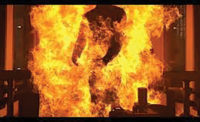Training
IEEE 1584: What to know about your next arc flash analysis
Complex calculations

Credit: Getty Images
Any organization utilizing electrical assets in their production environments or facilities will be aware of National Fire Protection Association (NFPA) 70E — Standard for Electrical Safety in the Workplace. This standard is what OSHA uses when assessing companies’ adherence to certain safety standards. However, NFPA 70E is further informed by the standard 1584-2018, which is developed by the Institute of Electrical and Electronics Engineers (IEEE).
This standard serves as a guide for inspectors to use when calculating the arc flash boundary and incident energy that workers could be exposed to while using or working near live electrical equipment. Before its most recent 2018 update, IEEE 1584-2018 was last updated in 2002.
With so much time between updates, companies understandably may have become accustomed to the standard five-year arc flash analysis requirement and what it entailed. And because the analysis is conducted once every five years, companies may not have taken notice of the update to the IEEE 1584 standard that was introduced in November of 2018. Vendors would have reviewed the changes and updated their systems and process to start offering the assessments in the following year based on the new IEEE 1584-2018 standard.
Regardless of where a company stands in its five-year arc flash analysis cycle, it’s important to understand what is required and how it will impact future arc flash hazard analysis projects. For now, let’s take a look at the new requirements of IEEE 1584-2018.
More extensive calculations
Perhaps the most significant aspect of IEEE 1584 is that it establishes the equations for calculating incident energy at different working distances. Over the 16 years between the 2002 and 2018 versions, the NFPA and IEEE committees responsible for developing the standard collaborated in-depth and completed almost 2,000 tests compared to approximately 300 conducted to generate the 2002 standard. This was done to further refine the calculations and also included additional variables for equipment dimensions and electrode configurations.
The result of the additional testing led to an update of IEEE 1584-2018 with a series of complex calculations that now factor in additional variables, such as equipment dimensions and the ability to account for the electrode configuration within an electrical asset. The formulas also allow for assets with voltages from 208 volts to 15,000 volts to be analyzed and for the results to be adjusted based on the asset’s specific voltage.
Enclosure dimensions
Prior to the 2018 update, IEEE 1584 did not account for the physical dimensions of an enclosure. This meant that the calculations were less accurate than the new models, as asset size can have a dramatic effect on the direction and concentration of an arc flash. IEEE 1584-2018 now accounts for entering the physical dimensions of enclosures in the calculations. This includes the asset’s height, width, and depth. For example, larger enclosures can lead to a decrease in incident energy based on a larger open area from the panel, and a smaller enclosure can lead to an increase in that energy. This seems logical because an arc flash occurring within a smaller space would focus the heat and other effects.
Documentation of electrode orientation
Regarding electrode configurations, the previous version of IEEE 1584 from 2002 was published accounting for only two versions: VCB (vertical conductors or electrodes inside of a metal enclosure) and VOA (vertical conductors or electrodes in open air). In the 2018 update, IEEE 1584 now includes a few more electrode orientations to support calculations for different types of electrical assets.
In addition to VCB and VOA orientations, IEEE 1584-2018 now supports calculations for HCB (horizontal conductors or electrodes inside a metal enclosure), VCBB (vertical conductors or electrodes terminated in an insulating barrier inside a metal enclosure), and HOA (horizontal conductors or electrodes in open air). The reason for including these additional orientations is that testing during the years between the 2002 and 2018 editions found that different configurations produced different incident energy and thus affected the arc flash boundary.
What these changes mean
If your organization requires an arc flash hazard analysis every five years, your next inspector should conduct that analysis using the new standards set forth in IEEE 1584-2018. This is critical, as OSHA conducts its inspections using NFPA and IEEE standards as guidelines. But what if your organization just recently had an arc flash hazard analysis performed on your facilities? Do you need to have another analysis completed to remain in compliance?
Your existing study is grandfathered in based on the active standard that was being enforced at the time the study was conducted. However, if you have added additional equipment, had an equipment retrofit, or expanded your facility, then those new items should utilize the new standard. It is recommended to have a discussion with your vendor to determine if it makes sense to redo the calculations for the rest of the facility based on the amount of new changes, compared to the existing equipment, and the age of the original report.
Additionally, keep in mind that the most recent update to NFPA 70E occurred in 2018 alongside the IEEE 1584 update. Because of the update cycles, some companies may not have had an arc flash analysis for a few years, meaning they will not have updated their report and other arc flash-related items for the 2018 NFPA update and the forthcoming 2021 update before having another analysis completed.
Be proactive, be prepared,and be safe
While the IEEE 1584-2018 updates introduced more complexity, the results were more accurate and adaptable calculations and processes for arc flash inspectors to use to provide better arc flash boundaries, incident energy levels, and PPE requirements. Investing in updating arc flash safety data and documentation now is an investment in the safety of employees and the protection of both electrical assets and the bottom line.
Looking for a reprint of this article?
From high-res PDFs to custom plaques, order your copy today!






